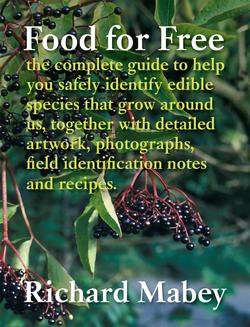Читать книгу Food for Free - Richard Mabey - Страница 18
ОглавлениеHazel Corylus avellana
An abundant and widespread tree, found in woods, hedgerows and scrubland. A small tree or multi-stemmed shrub, 1.5–3.5 m (4–12 ft) high, with roundish, downy, toothed leaves. Well known for the yellow male catkins, called ‘lambs’ tails’, which appear in the winter. Nuts from late August to October, 1–2.5 cm (½–1 inch) long, ovoid and encased in a thick green-lobed husk.
The hazel was among the first species to recolonise the British Isles after the last Ice Age. It is an extremely useful tree, with leaves that can be used as food for livestock, branches for building fences and shelters, and nuts that can be eaten as food. Widely eaten in prehistoric times, the hazelnut became part of Celtic legend – its compact shape, hard shell and nutritious fruit was an emblem of concentrated wisdom. Today they are grown commercially in many parts of the world, and are second only to the almond as a world nut crop. Hazelnuts begin to ripen in mid-September, at about the same time that the leaves begin to yellow. You may have to compete with the birds and squirrels, as the nuts do not just provide a treat for humans. Look for them at the edges of woods and in mature hedges. Search inside bushes for the nuts, as well as working round them, and scan them with the sun behind you if possible. Use a walking stick to bend down the branches, and gather the nuts into a basket that stays open whilst you are picking: a plastic bag with one handle looped over your picking wrist is a useful device.
If the ground cover under the bush is relatively clear of grass, then it is worthwhile giving the bush a shake. Some of the invisible ripe nuts should find their way onto the ground after this. In fact it is always worth searching the ground underneath a hazel. If there are nuts there which are dark or grey-brown in colour then the kernels will have turned to dust. But there is a chance that there will also be fresh windfalls that have not yet been picked at by birds.
Once you have gathered the nuts, keep them in a dry, warm place but in their shells, so that the kernels don’t dry out as well. You can use the nuts chopped or grated in salads, or with apple, raisins and raw oatmeal (muesli). Ground up in a blender, mixed with milk and chilled, they make a passable imitation of the Spanish drink horchata (properly made from the roots of the nutsedge, Cyperus esculentus). But hazelnuts are such a rich food that it seems wasteful not to use them occasionally as a protein substitute. Weight for weight, they contain fifty per cent more protein, seven times more fat and five times more carbohydrate than hens’ eggs. What better way of cashing in on such a meaty hoard than the unjustly infamous nut cutlet?
© Marcus Webb/FLPA
© Robert Canis/FLPA
To make hazelnut bread, grind a cupful of young nuts, and mix with the same amount of self-raising flour, half a cup of sugar and a little salt. Beat an egg with milk, and add it to the mixture, beating then kneading it until you have a stiff dough. Mould to a loaf shape, and bake in a medium oven for 50 minutes. Hazel leaves were used in the fifteenth century to make ‘noteye’, a highly spiced pork stew. The leaves were ground and mixed with ginger, saffron, sugar, salt and vinegar, before being added to minced pork.
Nut cutlet
50 g (2 oz) oil
50 g (2 oz) flour
500 ml (1 pint) stock
75 g (3 oz) breadcrumbs
50 g (2 oz) grated hazelnuts
Milk or beaten egg for glazing
Salt and pepper
• Mix the oil and flour in a saucepan. Add the stock and simmer for ten minutes, stirring all the time.
• Add the breadcrumbs and grated hazelnuts. Season.
• Cool the mixture and shape into cutlets.
• Dip the cutlets into an egg and milk mixture, coat with breadcrumbs and fry in oil until brown.
